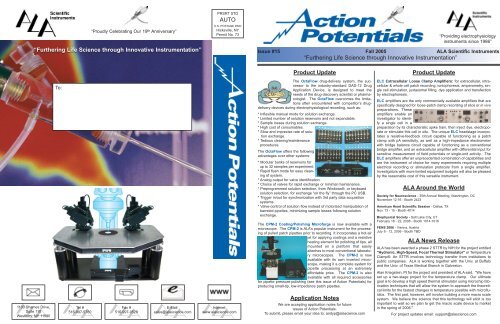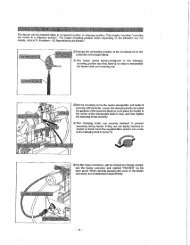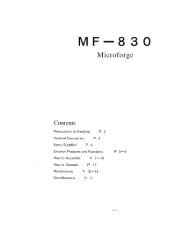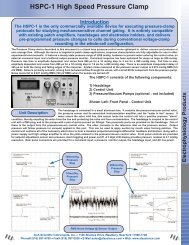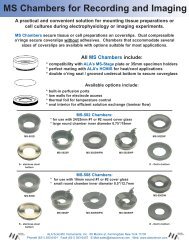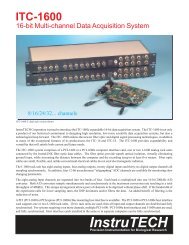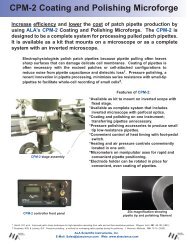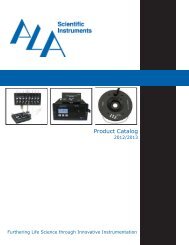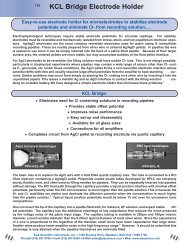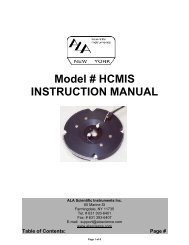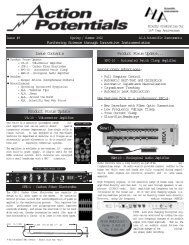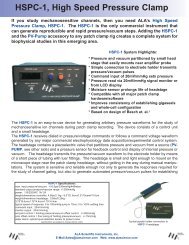Action Potential Issue #15 - ALA Scientific Instruments
Action Potential Issue #15 - ALA Scientific Instruments
Action Potential Issue #15 - ALA Scientific Instruments
Create successful ePaper yourself
Turn your PDF publications into a flip-book with our unique Google optimized e-Paper software.
“Proudly Celebrating Our 19 th Anniversary”<br />
“Furthering Life Science through Innovative Instrumentation”<br />
PRSRT STD<br />
AUTO<br />
U.S. POSTAGE PAID<br />
Hicksville, NY<br />
Permit No. 73<br />
“Providing electrophysiology<br />
instruments since 1986”<br />
<strong>Issue</strong> <strong>#15</strong> Fall 2005 <strong>ALA</strong> <strong>Scientific</strong> <strong>Instruments</strong><br />
“Furthering Life Science through Innovative Instrumentation”<br />
Product Update<br />
Product Update<br />
1100 Shames Drive,<br />
Suite 110<br />
Westbury, NY 11590<br />
To:<br />
Tel #<br />
516-997-5780<br />
Fax #<br />
516-997-0528<br />
E-Mail:<br />
sales@alascience.com<br />
Internet:<br />
www.alascience.com<br />
The OctaFlow drug-delivery system, the successor<br />
to the industry-standard DAD-12 Drug<br />
Application Device, is designed to meet the<br />
needs of the drug-discovery scientist or pharmacologist.<br />
The OctaFlow overcomes the limitations<br />
often encountered with competitor’s drugdelivery<br />
devices during electrophysiological recording, such as:<br />
* Inflexible manual mode for solution exchange.<br />
* Limited number of solution reservoirs and not expandable.<br />
* Sample losses during solution exchange.<br />
* High cost of consumables.<br />
* Slow and imprecise rate of solution<br />
exchange.<br />
* Tedious cleaning/maintenance<br />
procedures.<br />
The OctaFlow offers the following<br />
advantages over other systems:<br />
* Modular banks of reservoirs for<br />
up to 32 samples per experiment.<br />
* Rapid flush mode for easy cleaning<br />
of system.<br />
* Analog output for valve identification.<br />
* Choice of valves for rapid exchange or minimal maintenance.<br />
* Preprogrammed solution selection, from Windows®, or keyboard<br />
solution selection, for exchange “on the fly” through the PC USB.<br />
* Trigger in/out for synchronization with 3rd party data acquisition<br />
systems.<br />
* Valve-control of solution flow instead of motorized manipulation of<br />
barreled pipettes, minimizing sample losses following solution<br />
exchange.<br />
The CPM-2 Coating/Polishing Microforge is now available with a<br />
microscope. The CPM-2 is <strong>ALA</strong>’s popular instrument for the processing<br />
of pulled patch pipettes prior to recording. It incorporates a hot-air<br />
jet for applying coatings and a resistive<br />
heating element for polishing of tips, all<br />
mounted on a platform that easily<br />
attaches to most conventional laboratory<br />
microscopes. The CPM-2 is now<br />
available with its own inverted microscope,<br />
making it a complete system for<br />
pipette processing at an extremely<br />
affordable price. The CPM-2 is also<br />
available with all required accessories<br />
for pipette pressure-polishing (see this issue of <strong>Action</strong> <strong>Potential</strong>s) for<br />
producing small-tip, low-impedance patch pipettes.<br />
Application Notes<br />
We are accepting application notes for future<br />
issues of <strong>Action</strong> <strong>Potential</strong>s.<br />
To submit, please email your idea to: andyp@alascience.com<br />
ELC Extracellular Loose Clamp Amplifiers: for extracellular, intracellular<br />
& whole cell patch recording, iontophoresis, amperometry, single<br />
cell stimulation, juxtasomal filling, dye application and transfection<br />
by electrophoresis.<br />
ELC amplifiers are the only commercially available amplifiers that are<br />
specifically designed for loose-patch clamp recording of slice or in vivo<br />
preparations. These<br />
amplifiers enable an<br />
investigator to identify<br />
a single cell in a<br />
preparation by its characteristic spike train, then inject dye, electroporate<br />
or stimulate this cell in situ. The unique ELC headstage incorporates<br />
a resistive-feedback circuit capable of functioning as a patch<br />
clamp with pA sensitivity, as well as a high-impedance electrometer<br />
with bridge balance circuit capable of functioning as a conventional<br />
bridge amplifier, and an extracellular amplifier with differential input for<br />
sensitive measurement of field potentials or single-unit activity. The<br />
ELC amplifiers offer an unprecedented combination of capabilities and<br />
are the instrument of choice for many experiments requiring multiple<br />
electrical recording or stimulation protocols from a single amplifier.<br />
Investigators with more limited equipment budgets will also be pleased<br />
by the reasonable cost of this versatile instrument.<br />
<strong>ALA</strong> Around the World<br />
Society for Neuroscience - 35th Annual Meeting, Washington, DC<br />
November 12-16 - Booth 2423<br />
American Heart <strong>Scientific</strong> Session - Dallas, TX<br />
Nov. 13 - 15 - Booth 4014<br />
Biophysical Society - Salt Lake City, UT<br />
February 18 - 22, 2006 - Booth 1014-1016<br />
FENS 2006 - Vienna, Austria<br />
July 8 - 12, 2006 - Booth TBD<br />
<strong>ALA</strong> News Release<br />
<strong>ALA</strong> has been awarded a phase 2 STTR by NIH for the project entitled<br />
"Hydronic, High-Speed, Focal Thermal Stimulator" or Temperature<br />
Clamp®. An STTR involves technology transfer from institutions to<br />
public companies. <strong>ALA</strong> is working together with the Univ. at Buffalo<br />
and the Univ. of Texas Medical Branch in Galveston.<br />
Alan Kriegstein, PI for the project and president of <strong>ALA</strong> said, "We have<br />
set up a two-stage project for the temperature clamp. Our ultimate<br />
goal is to develop a high speed thermal stimulator using microchip fabrication<br />
techniques that will allow the system to approach the theoretical<br />
limits for the fastest changes in temperature possible with microfluidics.<br />
The first part, however, will involve building a more macro scale<br />
system. We believe the science that this technology will elicit is too<br />
important to wait so we plan to get the macro scale device to market<br />
in the spring of 2006."<br />
For project updates email: support@alascience.com
A Practical Guide to Pressure Polishing<br />
Miriam B. Goodman, Assistant Professor<br />
Dept. of Molecular & Cellular Physiology<br />
Stanford University School of Medicine<br />
Stanford, CA 94305 USA<br />
Seminars, symposia, and technical workshops<br />
sponsored by <strong>ALA</strong> <strong>Scientific</strong>, npi electronic,<br />
Multi Channel Systems, and e.IP<br />
Typical patch pipettes have tip openings of ~2 µm in<br />
diameter and are sharply tapered. For a variety of applications,<br />
smaller tip openings and a blunt shape are desirable.<br />
For example, my colleagues and I routinely record<br />
from C. elegans neurons (see Goodman et al., 1998;<br />
Pierce-Shimomura et al., 2001; O'Hagan et al., 2005)<br />
whose tiny cell bodies (1 to 3 µm in diameter) demand<br />
pipettes with smaller tip openings. A blunt shape offers<br />
several advantages even for pipettes with more typical tip<br />
openings. First, a blunt pipette has a lower resistance<br />
than a sharply tapered pipette with a similar tip opening<br />
(13±2 MΩ vs. 5±1 MΩ , see Table 1 of Goodman and<br />
Lockery, 2000). Second, a blunt pipette results in a larger<br />
membrane bleb, presenting a larger surface area for<br />
perforated patch recordings.<br />
About five years ago, Shawn Lockery and I described a<br />
method for shaping patch pipettes during pressure polishing<br />
(Goodman and Lockery, 2000). We were motivated<br />
to develop this method by the need to reliably fabricate<br />
pipettes with<br />
Fig. 1<br />
sub-micron tip<br />
openings and<br />
resistances<br />
less than 10<br />
Closeup of CPM-2 stage MΩ. We found<br />
that glasses<br />
that naturally<br />
formed blunt<br />
tips (e.g. R-6)<br />
were amenable<br />
to making such<br />
pipettes.<br />
CPM-2 controller Unfortunately,<br />
such glasses<br />
are notoriously<br />
noisy (Rae and<br />
Levis, 1992), while glasses with adequate electrical properties<br />
do not readily form blunt shapes (Table 1).<br />
Pressure polishing offers a solution to this puzzle: a reliable<br />
way to make blunt pipettes with sub-micron tip openings<br />
from low-noise borosilicate glasses.<br />
This is a practical guide for using pressure polishing in<br />
your laboratory. Our pressure polishing rig consists of an<br />
inverted microscope designed for routine tissue culture<br />
work equipped with a CPM-2 kit from <strong>ALA</strong> <strong>Scientific</strong><br />
<strong>Instruments</strong> including a high-pressure pipette holder, an<br />
ultra-long working distance 100X dry objective, a manual<br />
valve for directing pressurized air through the pipette<br />
lumen, and a sure regulator connected to the building's<br />
pressurized air supply (Fig. 1). (My lab uses a Leica PL<br />
FL L 100x/0.75, 4.7 mm working distance; comparable<br />
lenses are also available from the metallurgical lines for<br />
other microscope.) This set-up offers superior optics<br />
compared to dedicated microforges that lack a condenser<br />
and cannot accommodate a long working-distance highpower<br />
objective.<br />
In practice, pressure polishing involves four steps, is as<br />
quick as standard fire-polishing, and, once the technique<br />
has been mastered, it is quite reliable:<br />
1) Mount the pipette in the high-pressure holder and position<br />
it so that the pipette tip is level with the polishing filament<br />
at high magnification. It is wise to position the polishing<br />
filament just outside the field of view of the 100X<br />
objective, as it will expand during heating.<br />
2) Direct pressurized air (~40 PSI) down the lumen of the<br />
pipette and activate the polishing coil. During this step<br />
the pipette tip should expand slightly. If this step is prolonged,<br />
the tip will expand like a balloon and burst!<br />
3) Turn off the pressured air and polish the tip to the<br />
desired tip opening size.<br />
4) Double-check to ensure that the pressurized air is off,<br />
then remove the pipette from its holder.<br />
References:<br />
Goodman MB, Lockery SR (2000) Pressure polishing: a method for re-shaping<br />
patch pipettes during fire polishing. J Neurosci Methods 100:13-15.<br />
Goodman MB, Hall DH, Avery L, Lockery SR (1998) Active currents regulate<br />
sensitivity and dynamic range in C. elegans neurons. Neuron 20:763-772.<br />
O'Hagan R, Chalfie M, Goodman MB (2005) The MEC-4 DEG/ENaC channel<br />
of Caenorhabditis elegans touch receptor neurons transduces mechanical signals.<br />
Nat Neurosci 8:43-50.<br />
Pierce-Shimomura JT, Faumont S, Gaston MR, Pearson BJ, Lockery SR (2001)<br />
The homeobox gene lim-6 is required for distinct chemosensory representations<br />
in C. elegans. Nature 410:694-698.<br />
Rae JL, Levis RA (1992) Glass technology for patch clamp electrodes. Methods<br />
Enzymol 207:66-92.<br />
Future issues of <strong>Action</strong> <strong>Potential</strong>s:<br />
Multielectrode array analysis of circadian synchrony within<br />
the suprachiasmatic nucleus<br />
Sara J. Aton and Erik D. Herzog<br />
Department of Biology, Washington University in St. Louis; St. Louis,<br />
MO 63130<br />
Gap Junction Recordings with two SEC amplifiers<br />
Jose F. Ek-Vitorin and Janis M. Burt<br />
Department of Physiology, University of Arizona, Tucson, AZ 85724<br />
Please stay tuned for news about the sixth annual<br />
Drug Discovery for Ion Channels satellite meeting at<br />
the Biophysical Society meeting in Salt Lake City,<br />
which <strong>ALA</strong> <strong>Scientific</strong> will be cosponsoring with<br />
Molecular Devices.<br />
SFN 2005<br />
Symposium: Microelectrode &<br />
Multielectrode Recording Techniques<br />
When: Tuesday, November 15, 2005<br />
Time: 5:30pm - 8:00pm<br />
Where: Washington Convention Center -<br />
Room: 209A<br />
Introduction and Overview<br />
Alan Kriegstein, President, <strong>ALA</strong> <strong>Scientific</strong> <strong>Instruments</strong><br />
Reiner Polder, Vice President, e.IP<br />
“Pharmacology of two Nicotinic Acetylcholine Receptor<br />
Subtypes on Insect CNS Neurons Studied with the Single-<br />
Electrode Voltage Clamp Technique”<br />
Dr. Vincent L. Salgado, BASF Corporation<br />
“Neuronal avalanches and information storage: A few strong<br />
connections”<br />
Dr. John Beggs, Indiana University<br />
"Leading and Dominance Asymmetry In Coupled Neural<br />
Networks"<br />
Itay Baruchi, Tel Aviv University<br />
“The synapse is not everything: Modulation of excitability and<br />
electrical coupling and their contribution to learning”<br />
Dr. Brian D. Burrell, University of South Dakota<br />
“Perforated Microelectrode Arrays Optimize Oxygen<br />
Availability and Signal-to-Noise Ratio in Brain Slice<br />
Recordings”<br />
Dr. Uli Egert, University Freiburg<br />
O'Hagan R., Chalfie M. and Goodman M.B. (2005) The MEC-<br />
4 DEG/ENaC channel of Caenorhabditis elegans touch receptor<br />
neurons transduces mechanical signals. Nat Neurosci. 8<br />
pp. 43-50.<br />
This study features the use of the "pressure-polishing technique" to form lowimpedance<br />
small-tip patch pipettes, an essential capability for in vivo patch<br />
clamp recordings of C. elegans neurons (see applications note this issue).<br />
Fukuda, K., Nakajima, T., Viswanathan, P.C. and Balser, J.R.<br />
(2005) Compound-specific Na+ channel pore conformational<br />
changes induced by local anesthetics. J Physiol. 564 pp 21-<br />
31.<br />
This article is a mechanistic study of sodium channel pharmacology that features<br />
the use of the <strong>ALA</strong> HSSE system for high-speed solution exchange.<br />
Akitake, B., Anishkin, A. and Sukharev, S. (2005) The<br />
"Dashpot" mechanism of stretch-dependent gating in MscS. J.<br />
Gen. Physiol. 125 pp. 143-154<br />
The <strong>ALA</strong> HSPC, high-speed pressure clamp, is used to induce rapid pressure<br />
changes to mechanosensitive ion channels in the whole-cell patch<br />
Interesting Current Papers:<br />
FENS 2006<br />
Technical Workshop: Noninvasive, highresolution<br />
recording<br />
When: July 8-12, 2006<br />
Where: Vienna, Austria<br />
Organized by: Andreas Draguhn (Univ.<br />
Heidelberg) and Hans Reiner Polder (npi<br />
electronic)<br />
The recent merge of cellular and network physiology makes it<br />
necessary to analyze the behavior of individual cells within<br />
multi-cellular ensembles. Therefore, various approaches have<br />
been developed to combine single-cell techniques with largescale<br />
approaches. Many of these techniques allow recording<br />
neuronal activity without penetration of the cell by an electrode.<br />
Such recordings can be combined with staining and<br />
structural analysis of the cells. Moreover, elegant stimulation<br />
techniques by highly focal photo release of caged agonists<br />
allow for a mapping of cortical circuits. Together, optical, electrophysiological<br />
and histological approaches make it possible<br />
to combine high-resolution cell physiology with large-scale<br />
network analysis. Our workshop shall present several new<br />
methodological approaches from leading laboratories in the<br />
field of cellular and network physiology.<br />
Invited speakers:<br />
H.U. Dodt (Munich, Germany), D. Pinault (Strasbourg,<br />
France), D. Schubert (Düsseldorf, Germany), Y. Kovalchuk<br />
(Munich, Germany), R. Mason (Cambridge, United Kingdom),<br />
R. Bruno (Heidelberg, Germany)<br />
http://fens2006.neurosciences.asso.fr/pages/sympo.html#52<br />
<strong>ALA</strong> <strong>Scientific</strong> <strong>Instruments</strong> is dedicated to providing the scientific community with instruments that can address the most fundamental<br />
questions in neuroscience and biophysics. We are proud to present the following examples of seminal studies employing<br />
our instruments:<br />
configuration.<br />
The ability to record from multiple electrodes in a defined<br />
spatial arrangement is a significant advance in extracellular<br />
recording techniques. Below are three very diverse applications<br />
of this important technology:<br />
Aton SJ, Colwell C.S, Harmar A.J, Waschek J and Herzog<br />
E.D. (2005) Vasoactive intestinal polypeptide mediates circadian<br />
rhythmicity and synchrony in mammalian clock neurons.<br />
Nat Neurosci. 8 pp. 476-83.<br />
E. Kolossov , Z. Lu , I. Drobinskaya, N. Gassanov , Y. Duan,<br />
H. Sauer, O. Manzke, W. Bloch, H. Bohlen, J. Hescheler and<br />
Fleischmann, B.K. (2005) Identification and characterization<br />
of embryonic stem cell-derived pacemaker and atrial cardiomyocytes.<br />
FASEB J. 19 pp. 577-9<br />
M. J. Berry, J. L. Puchalla, E. Schneidman and Harris, R.A.<br />
(2005) Redundancy in the population code of the retina.<br />
Neuron 46 pp. 493-50


